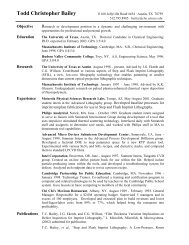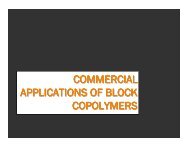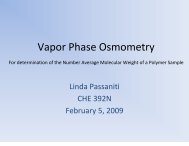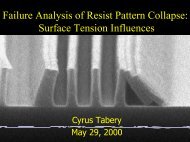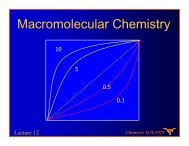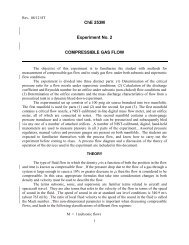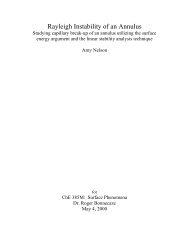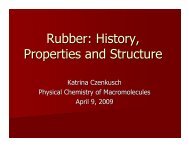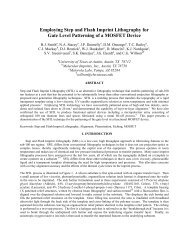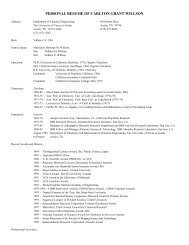Asymmetric fluid-structure dynamics in nanoscale imprint lithography
Asymmetric fluid-structure dynamics in nanoscale imprint lithography
Asymmetric fluid-structure dynamics in nanoscale imprint lithography
- No tags were found...
Create successful ePaper yourself
Turn your PDF publications into a flip-book with our unique Google optimized e-Paper software.
2 2( r − r )3µb dh − 2γp = [2.38]3h dt hThe force is obta<strong>in</strong>ed by <strong>in</strong>tegrat<strong>in</strong>g with respect to r and θF42⎛ − 3µr − ⎞b dh γrb= 2π ⎜⎟3[2.39]⎝ 4hdt h ⎠Equations 2.38 and 2.39 were used to perform numerical simulations of theequation of motion where <strong>fluid</strong> is modeled with boundary conditions that evolveas the <strong>fluid</strong> is squeezed out from between the surfaces. This is discussed <strong>in</strong>Chapter 4.2.5 TOPOGRAPHY EFFECTSThe ratio h is an important parameter show<strong>in</strong>g the effects of surfaceσroughness. For h >> 3 , the roughness effects are not important, and theσpressure distribution for corrugated surfaces are qualitatively the same as for flatplate film theory. The roughness effects become important as h → 3σ[Patir andCheng 1978]. The local film thickness is h T= h + δ1+ δ2where h is thenom<strong>in</strong>al film thickness def<strong>in</strong>ed as the distance between the mean levels of the twosurfaces. δ 1 and δ 2 are the roughness amplitudes of the two surfaces measuredfrom their mean levels with zero mean and standard deviations σ 1 and σ 2 . Theparameter σ is the composite standard deviation of surface2 2heightsσ = σ 1+ σ .2Assume that the height of the features on the templates is on average 200nm, and that to maximize the density of the circuit elements, the l<strong>in</strong>e widths (LW)39



